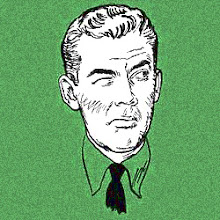 Airing live on Playhouse 90, April 22, 1960: John Franken- heimer's direction of the Rogert O. Hirsen script, Journey to the Day, in which six patients in a state mental hospital are brought together for group therapy. The play was based on actual conditions at two mental hospitals, one in Ohio and the other at St. Vincent's in NYC. Mike Nichols plays one of the roles, as does Steven Hill. That's Frankenheimer, standing, and Nichols seated in the center. Mary Astor stands behind Nichols and Steven Hill has his back to us, at left. I've ordered the playscript and look forward to reading it.
Airing live on Playhouse 90, April 22, 1960: John Franken- heimer's direction of the Rogert O. Hirsen script, Journey to the Day, in which six patients in a state mental hospital are brought together for group therapy. The play was based on actual conditions at two mental hospitals, one in Ohio and the other at St. Vincent's in NYC. Mike Nichols plays one of the roles, as does Steven Hill. That's Frankenheimer, standing, and Nichols seated in the center. Mary Astor stands behind Nichols and Steven Hill has his back to us, at left. I've ordered the playscript and look forward to reading it.
Friday, January 2, 2009
group therapy live on TV
 Airing live on Playhouse 90, April 22, 1960: John Franken- heimer's direction of the Rogert O. Hirsen script, Journey to the Day, in which six patients in a state mental hospital are brought together for group therapy. The play was based on actual conditions at two mental hospitals, one in Ohio and the other at St. Vincent's in NYC. Mike Nichols plays one of the roles, as does Steven Hill. That's Frankenheimer, standing, and Nichols seated in the center. Mary Astor stands behind Nichols and Steven Hill has his back to us, at left. I've ordered the playscript and look forward to reading it.
Airing live on Playhouse 90, April 22, 1960: John Franken- heimer's direction of the Rogert O. Hirsen script, Journey to the Day, in which six patients in a state mental hospital are brought together for group therapy. The play was based on actual conditions at two mental hospitals, one in Ohio and the other at St. Vincent's in NYC. Mike Nichols plays one of the roles, as does Steven Hill. That's Frankenheimer, standing, and Nichols seated in the center. Mary Astor stands behind Nichols and Steven Hill has his back to us, at left. I've ordered the playscript and look forward to reading it.

 Is '60 the moment when the end of the end of the Old Left had been reached and the New Left began to emerge? Is it the final ascendancy, in certain scenes at least, of poetic postmodernity? Surely the publication of Donald Allen's The New American Poetry that year suggests this, but then again--once again--we look back on "New" here and see continuity. The rhetoric of the Kennedy-Nixon contest made much less of a dent than everyone (at the time as well as since) claimed, so one wonders why were such great claims made?
Is '60 the moment when the end of the end of the Old Left had been reached and the New Left began to emerge? Is it the final ascendancy, in certain scenes at least, of poetic postmodernity? Surely the publication of Donald Allen's The New American Poetry that year suggests this, but then again--once again--we look back on "New" here and see continuity. The rhetoric of the Kennedy-Nixon contest made much less of a dent than everyone (at the time as well as since) claimed, so one wonders why were such great claims made?  Had we come to expect "1960" to be truly ubiquitously modern in a way that the 1950s really were not--not quite? And what specifically does "modern" mean in the Kennedyesque talk then and now about the torch being passed to a new generation, etc.? The First Lady really meant "modernist" when Camelotians said "modern." What about the others across the new young cultural leadership? I've been surprised by how frequently the
Had we come to expect "1960" to be truly ubiquitously modern in a way that the 1950s really were not--not quite? And what specifically does "modern" mean in the Kennedyesque talk then and now about the torch being passed to a new generation, etc.? The First Lady really meant "modernist" when Camelotians said "modern." What about the others across the new young cultural leadership? I've been surprised by how frequently the  "Beat movement" was covered in 1960 in the mainstream press. I was expecting a fair measure but I've found tonnage. 1960 was the year when the figure of the beat was beginning to find acceptance, although still 80% of these stories are mocking, rebels-without-cause condescension. For anyone whose analysis made an impact nationally, do these antipolitical adolescents count as part of the "new young cultural leadership"? No, but rather than the two being opposites, they fall along a Continuum of the New American. Now that's a change for '60.
"Beat movement" was covered in 1960 in the mainstream press. I was expecting a fair measure but I've found tonnage. 1960 was the year when the figure of the beat was beginning to find acceptance, although still 80% of these stories are mocking, rebels-without-cause condescension. For anyone whose analysis made an impact nationally, do these antipolitical adolescents count as part of the "new young cultural leadership"? No, but rather than the two being opposites, they fall along a Continuum of the New American. Now that's a change for '60.







